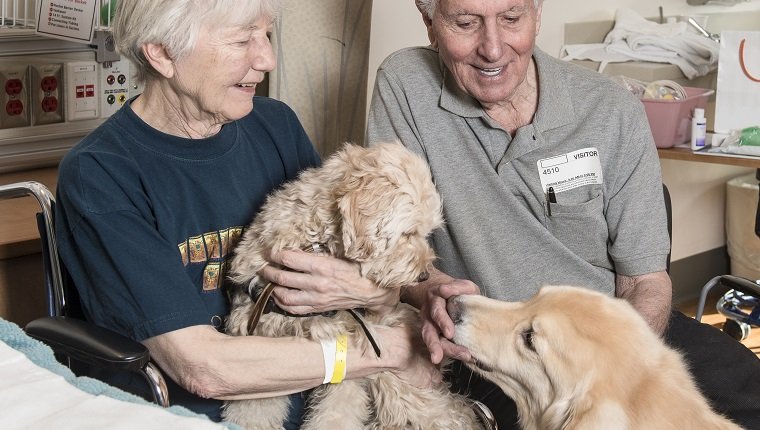If you think your dog has an amazingly caring, calm, and obedient personality, you may want to share your pup’s love with people who could benefit from a therapy animal visit.
Hospitals, schools, rehabilitation centers, nursing homes, and other places are always in need of the help provided by volunteers who show up with their therapy animals. If you want to donate your time and some of your dog’s affection to a worthy cause, you should absolutely consider having your dog registered as a therapy animal.
Be prepared, though, because the process for becoming a therapy animal is not easy, and there are some things you should know before you begin registering your therapy dog.
Beware Of Scams

Some websites will offer you packages that may cost hundreds of dollars for bogus therapy animal registration with promises of sending you IDs, vests, badges, and other accessories, along with a registration in their “databases.” These are not likely to be legitimate.
You should always check to make sure that the organization you’re registering with is a non-profit 501(c)(3) organization.
People who want to legitimately register therapy dogs aren’t interested in profiting from it. They only want to help you and your animal provide care to people in need.
Your Dog Needs To Pass Tests
Also, the tests for becoming a therapy animal are rigorous. So any site that says you can register without testing is not worth the money you’re going to spend.
The American Kennel Club (AKC) has a list of national organizations in the United States that work with their therapy dog program, as well as local organizations by state. You should start there when looking for a non-profit to register your dog.
Therapy Dogs Are Not The Same As Service Dogs Or ESAs
It’s important to note that therapy animals are not the same as service animals or emotional support animals.
Service animals are trained to provide a certain function for a specific individual with a medical condition. Emotional support animals provide comfort to those with certain needs that have been evaluated by a therapist.
You can register your dog as both a therapy dog and as a service or emotional support animal, but the processes and requirements are very different.
If any site fails to differentiate between these types of animals or offers you some kind of bundle package to register as multiple types, it is not legitimate.
Why Do You Need To Register Your Dog As A Therapy Animal?

Can’t you just show up with your well-behaved animal at a facility in need? Wouldn’t they appreciate your presence, even if you aren’t registered?
No, they probably wouldn’t.
First, they don’t know who you are or how your dog will interact with their patients, residents, or other people in the building.
Second, if there is an incident, whose insurance covers the cost? Are there other therapy animals in the building? How will your dog react to them? Will they be scared around unfamiliar noises and smells? Will they eat medicine that has fallen on the ground?
You need to think of the safety of your dog and everyone else around you.
When you register your dog as a therapy dog, you are making it clear that they have passed rigorous testing to make sure they know how to react to a variety of new and potentially stressful situations.
Facilities that you bring your dog to will know that your animal will behave safely around the people they’re caring for. In addition — this is super important — you will be insured by the organization that you register with.
Make sure that any non-profit you use to register your dog provides you with insurance. This information should be available on their website, potentially in the FAQ section if it does not appear somewhere more obvious.
What Is The Therapy Dog Testing Like?

Different organizations may handle testing differently. Many use the AKC’s Canine Good Citizens (CGC) test as a basis, though not all do.
You’ll most likely have to schedule an appointment with a qualified tester/observer through the organization you’re registering with to conduct the test.
You’ll need to pay some necessary fees and fill out some paperwork. Most organizations include an annual fee to maintain membership, but this shouldn’t be astronomical.
The evaluation will probably include a basic obedience test making sure your dog knows important commands like sit, stay, heel, and so on. They will not need to know any fancy tricks.
Testing Is Vigorous & Can Vary
Organizations vary in how thorough they are with testing, but they’ll probably want to meet with you and your dog to see how you handle them.
They may try to greet you with hugs, vigorous handshakes, and lots of physical touch to make sure your dog won’t react negatively to seeing you approached by strangers.
They will give the same treatment to your dog, touching them, hugging them, and trying to expose them to new greetings to observe their reaction. The test may include interacting with your pet in unusual ways.
The tester might carry a cane and wave it around, occasionally bumping your dog gently. They may use a wheelchair or walker, drop objects, or expose your dog to a crowd. They might speak unnaturally or behave oddly. All of this is to make sure your dog reacts appropriately and doesn’t show signs of stress.
Some tests include a portion that tests your dog in a group of other dogs and handlers. There may also be a portion where your dog is handled by someone other than you while you stay out of sight. Your dog might have to interact with children or other therapy animals.
Once your dog has completed all of the rigorous testing, they’ll probably need to have one or more supervised visits. You and your dog will need to go to a facility and provide therapy dog services while an observer shadows you. If your dog performs well, then your tester will sign off on your paperwork.
After Your Dog Passes The Tests, What’s Next?

Once you file all the paperwork, pay all the fees, and follow all of the instructions of the organization you’re registering with, they’ll likely send you an ID with a photo of your dog to verify their status as a certified and registered therapy animal.
You shouldn’t need any kind of special vest or accessories other than a leash and collar. However, your organization will let you know if you do.
When planning your visit to a facility in need of therapy animals, don’t just show up unannounced. You’ll need to contact the facility and schedule a visit. Then you must check in when you arrive, wait for instructions, and check out when you leave.
Make sure to bring identification for yourself and your dog.
Remember, this is a done on a volunteer basis and is not for pay.
Always show up on time, and make sure you and your dog are ready.
Therapy Dog Titles
The AKC offers different therapy dog titles based on how many visits you do with your dog. There are several requirements to earn these titles, but you’ll need to record your visits on a sheet provided by the AKC and get signatures from staff at the facility at which you’re volunteering.
The most basic title of AKC Therapy Dog Novice is given to dogs who complete ten visits, while the most advanced title is AKC Therapy Dog Distinguished, which is earned after 400 visits. There are several other titles in between.
It’s not necessary to achieve these titles to remain a registered therapy dog. They’re just nice acknowledgements of your pup’s dedication.
Does your dog have what it takes to be a therapy animal? Have you provided therapy dog services to a facility in need? Then let us know in the comments below!









